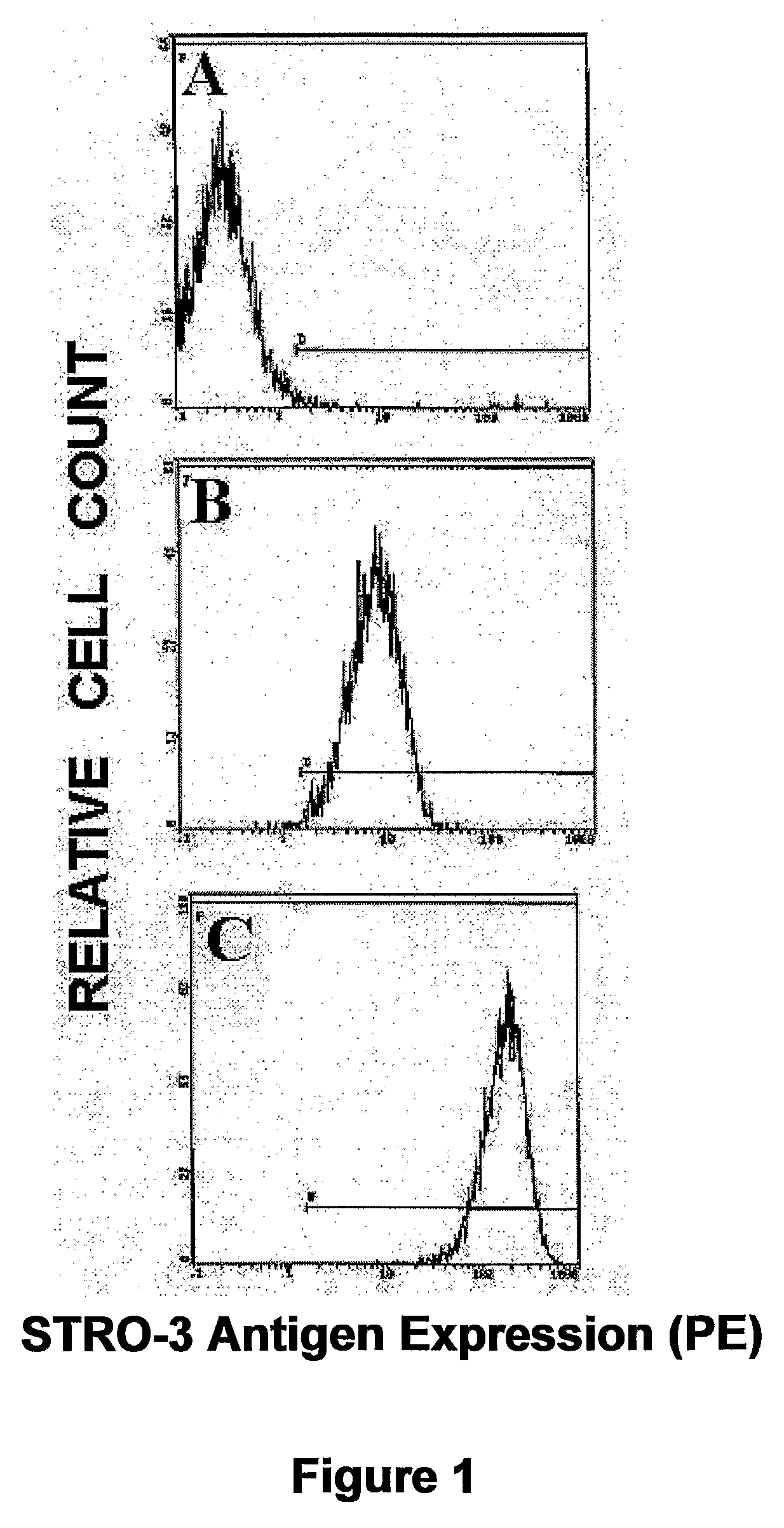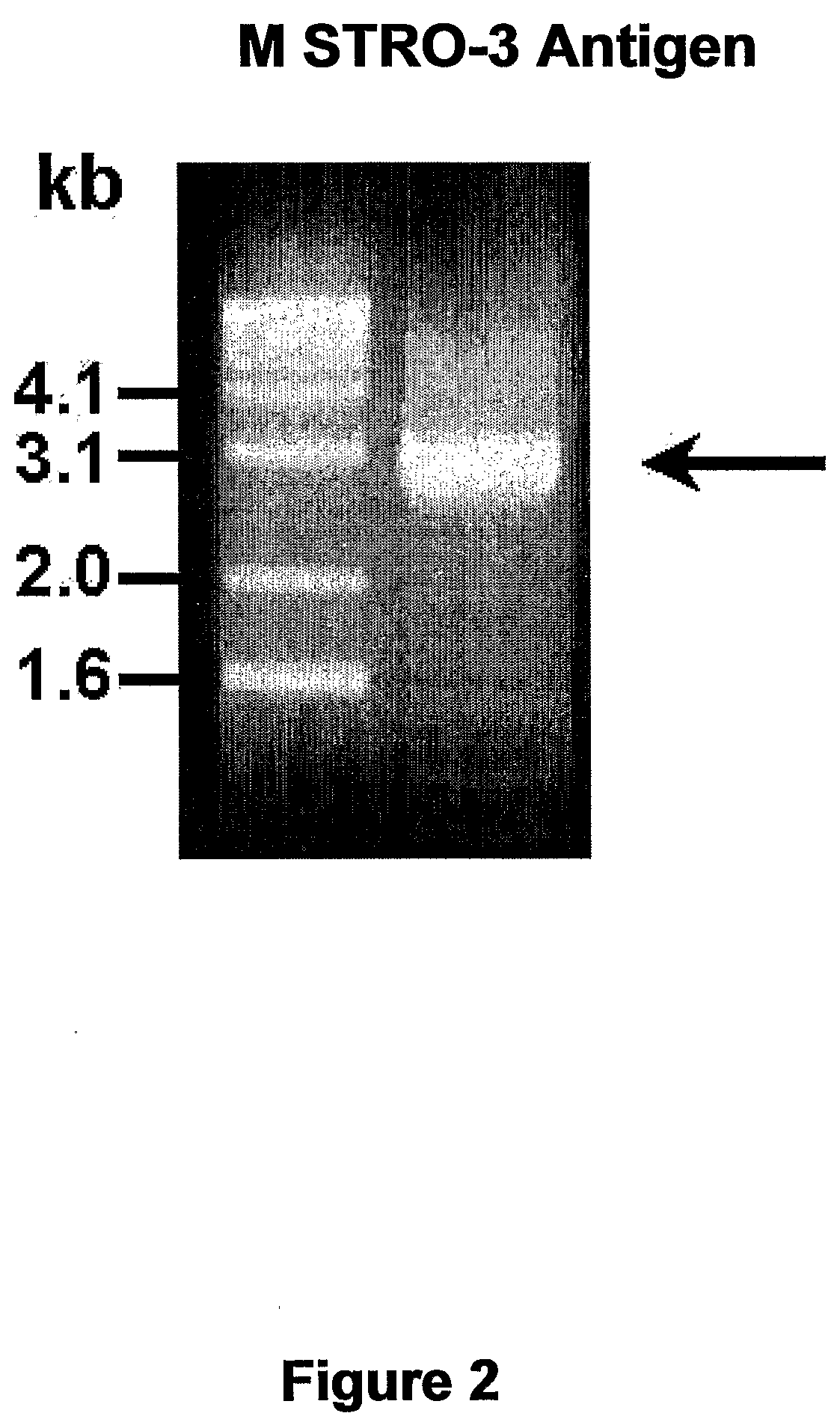Isolation of adult multipotential cells by tissue non-specific alkaline phosphatase
a technology of non-specific alkaline phosphatase and multipotential cells, which is applied in the direction of hydrolases, cell culture supports/coatings, unknown materials, etc., can solve the problems that cbfa1 cannot be used to isolate and manipulate living cells within a heterogeneous cell population, and represents a major limitation, so as to achieve the effect of increasing the rate of haemopoiesis
- Summary
- Abstract
- Description
- Claims
- Application Information
AI Technical Summary
Benefits of technology
Problems solved by technology
Method used
Image
Examples
example 1
Generation of the mAb STRO-3
Materials and Methods
Human MPC Cultures
[0263]Stromal cultures were established, essentially as described previously (Gronthos et al., 2003). The use of normal bone marrow (BM) cells for these studies was approved by the Human Ethics Committee of the Royal Adelaide Hospital, Australia. After washing thrice in “HHF” (Hanks Buffered Salt Solution (HBSS) supplemented with 20 mM HEPES and 5% FCS), the 1-5×107 bone marrow mononuclear cells (BMMNCs) were resuspended in 10 ml of alpha-modification of Eagles' medium (α-MEM: Flow Laboratories, Irvine, Scotland) supplemented with Folic acid (0.01 mg / ml), myo-inositol (0.4 mg / ml) (Sigma Chemical Co. St Louis, Mo.), 50 mM / L 2-mercaptoethanol, 1 mM / L hydrocortisone sodium succinate (Sigma), 123% FCS, and 12.5% horse serum (CSL, Melbourne, Australia) and cultured in 25 cm2 flasks (Becton Dickinson Labware, Franklin Lakes, N.J.), Upon development of a confluent stromal layer, the cells were detached using 0.05% (w / v) try...
example 2
Molecular Characterization of the STRO-3 Antigen
Materials and Method
[0265]Expression Cloning of the cDNA Encoding STRO-3 Antigen
[0266]The cDNA encoding the cell surface antigen identified by the mAb STRO-3 was isolated from a human bone marrow stromal cell cDNA library in the retroviral vector, pRUFneo as described (Zannettino et al., 1996). Briefly, cDNA synthesised from mRNA from HBMSC cultures was cloned into the retroviral vector pRUFneo. Plasmid DNA from the library was used to transfect a viral packaging line (PA317). Virus containing supernatant from these cells was used to infect the packing cell line ψ2, which in turn was used to infect the murine factor-dependent cell line BAF-3. Infected cells were selected for G418 resistance, labelled with STRO-3 antibody and cells specifically binding the antibody were isolated by immunomagnetic bead selection (Dynabead, Dynal, Oslo, Sweden). After expansion of the initially selected cells in culture, immunomagnetic bead selection was ...
example 3
Immunohistochemical Detection of TNAP by STRO-3 mAb in Sections of BM Trephine
Materials and Methods
[0275]Five micron sections of paraffin-embedded normal post-natal bone, were cut onto 3-aminopropyl-triethoxysilane-coated slides and endogenous peroxidase activity blocked by incubation with 3% H2O2 / Methanol. Microwave antigen retrieval was then performed in the presence of 1 mM EDTA, pH 8.0 buffer. The slides were allowed to cool to 40° C. and non-specific binding blocked by incubating sections with 3% normal horse serum for 1 hour at RT. The slides were then incubated overnight with either an isotype-matched, non-binding control mAb (1B5, IgG1) or STRO-3 mAb. Bound antibody was revealed using a three-step immunoperoxidase method (Gronthos et al., 2000; Gronthos et al., 2003) in which slides were sequentially incubated with (a) affinity-purified HRP-conjugated goat anti-mouse antibody (Dako, Botany, NSW, Australia), followed by (b) affinity-purified Horseradish peroxidase (HRP)-conju...
PUM
| Property | Measurement | Unit |
|---|---|---|
| Volume | aaaaa | aaaaa |
| Volume | aaaaa | aaaaa |
| Volume | aaaaa | aaaaa |
Abstract
Description
Claims
Application Information
 Login to View More
Login to View More - R&D
- Intellectual Property
- Life Sciences
- Materials
- Tech Scout
- Unparalleled Data Quality
- Higher Quality Content
- 60% Fewer Hallucinations
Browse by: Latest US Patents, China's latest patents, Technical Efficacy Thesaurus, Application Domain, Technology Topic, Popular Technical Reports.
© 2025 PatSnap. All rights reserved.Legal|Privacy policy|Modern Slavery Act Transparency Statement|Sitemap|About US| Contact US: help@patsnap.com



